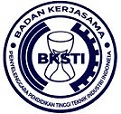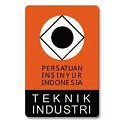Design of Temperature Monitoring Equipment for Furnaces Burning Charcoal Production
Abstract
Charcoal is generally a porous solid material made from carbon with a high degree of aromatization, the result of thermal decomposition of plant waste biomass in conditions without oxygen or with limited oxygen. This traditional method of making charcoal produces charcoal quality that is not optimal and requires constant supervision during the production process. Traditional furnaces or kitchens use soil as an insulator to retain heat during the carbonization process and prevent air from entering the furnace. Optimal combustion can be achieved if several factors in the operation of the furnace are taken into account, including temperature, duration of burning or carbonization, the process of reducing or closing the door, the process of closing the chimney, and the top window. This research aims to design a prototype temperature monitoring system for charcoal burning stoves based on the Arduino Uno microcontroller. This tool will help the operator to know the combustion temperature and completion time of the combustion process, so that the charcoal burning stove is more modern and efficient and can increase the productivity of charcoal making. This system is able to monitor temperatures in real-time and provide important information in handling production time problems. succeeded in increasing production time efficiency. Before using this monitoring tool, operators assumed the charcoal production process time was 12 days. However, after using this monitoring tool, it was discovered that the charcoal production process only took 10 to 11 days. In this way, there is a time saving of 1 to 2 days.
Keywords: Charcoal, Burning Furnace, Production Time, Efficiency
Full Text:
PDFReferences
Y. B. Yokasing, E. T. Kosat, A. Abdullah, and A. Pangalinan, “Rancang Bangun Teknologi Pembuatan Arang Tempurung Kelapa Cacahan,” J. Tek. Mesin, vol. 3, no. 2, pp. 6–11, 2020.
M. Jhonisius, “Analisis Perbaikan Kecacatan Produk Briket Menggunakan Metode Taguchi Pada Umkm Rumah Briket,” 2023.
Z. Darajat, M. Septiani, and Fitria, “Pengaruh Waktu Aktivasi Terhadap Karakterisasi Arang Aktif Tongkol Jagung dengan Menggunakan Aktivator H2SO4,” J. Juara, vol. 3, no. 1, pp. 8–15, 2023, [Online]. Available: https://www.sttibontang.ac.id/jurnal/index.php/jago
M. R. C. A. G. Daful, “Biochar Production From Biomass Waste-Derived Material,” Elsevier Ltd, 2020.
Prabir Basu, Biomass gasification, pyrolysis and torrefaction. joe hayton, 2018. [Online]. Available: https://books.google.co.id/books?hl=id&lr=&id=BYM2DwAAQBAJ&oi=fnd&pg=PP1&dq=basu+Biomass+gasification,+pyrolysis+and+torrefaction:+Practical+design+and+theory.+Academic+press,+2.&ots=nJlz75nAtN&sig=W3OWDmWPBD_FAJF6sf2xwQpiirs&redir_esc=y#v=onepage&q=basu
S. Teke, W. O. N. T. D. Dewi, W. Jali, and Y. Yumnawati, “Pembuatan dan Karakteristik Arang Aktif Ijuk Pohon Aren (Arenga pinnata) Sebagai Media Filtrasi Desalinasi Air Payau,” J. Berk. Fis., vol. 24, no. 1, pp. 10–21, 2021.
S. Wardani and R. Mirdayanti, “Optimasi Suhu Aktivasi Proses Pembuatan Arang Aktif Limbah Tulang Kambing,” J. Serambi Eng., vol. 4, no. 2, pp. 498–505, 2019, doi: 10.32672/jse.v4i2.1327.
B. W. Lope, A. T. Mandagi, and J. E. . Sumampouw, “Pengaruh penambahan serbuk arang kayu dan serat karung plastik terhadap nilai cbr laboratorium tanpa rendam,” J. Sipil Statik, vol. 7, no. 11, pp. 1427–1434, 2019.
J. Rochmadi, “Tungku Pembuat Arang Sebagai Media Pengganti Tanah Liat,” J. Politeknosain, vol. 21, no. 1, pp. 18–21, 2022.
J. Sulistyo, S. N. Marsoem, A. Kholik, and M. N. Wibowo, “Proses Pengarangan dari Tungku/Dapur Pengarang Konvensional dan Permanen di Wonosari, Gunungkidul.,” Semin. MAPEKI XX (Masyarakat Peneliti Kayu Indones. 2019, no. 1, pp. 206–216, 2019.
S. M. Ridjayanti, R. A. Bazenet, I. S. Banuwa, M. Riniarti, and W. Hidayat, “Karakteristik Arang Kayu Karet (Hevea Brasiliensis) Yang Diproduksi Menggunakan Dua Tipe Tungku Pirolisis,” J. Belantara, vol. 6, no. 1, pp. 12–22, 2023, doi: 10.29303/jbl.v6i1.815.
M. Z. Hidayatullah and Alfansuri, “Analisa Tungku Pembakaran Arang Untuk Meningkatkan Produktivitas Karbonisasi Arang,” J. Tek. Mesin, vol. 6, no. 1, p. 2, 2020.
Y. Darnita, A. Discrise, and R. Toyib, “Prototype Alat Pendeksi Kebakaran Menggunakan Arduino,” J. Inform. Upgris, vol. 7, no. 1, pp. 3–7, 2021, doi: 10.26877/jiu.v7i1.7094.
Fina Ayu Lestari and B. D. Cahyono, “Sistem Pengendali Mesin Solar Cells Automatic Tabber Stringer pada Penyolderan String di PT. Indonesia Solar Global,” INSOLOGI J. Sains dan Teknol., vol. 1, no. 5, pp. 543–552, 2022, doi: 10.55123/insologi.v1i5.856.
A. Yudhanto, A. P. Sari, N. Rachman, and S. Subairi, “Implementasi Sensor Thermocouple Berbasis Telemetri Untuk Mengukur Thermal Pembakaran Propelan Roket,” JASIEK (Jurnal Apl. Sains, Informasi, Elektron. dan Komputer), vol. 2, no. 1, 2020, doi: 10.26905/jasiek.v2i1.4284.
Barmawi, Azhar, and M. Kamal, “Rancang Bangun Penggunaan Sensor Thermocouple Pada Alat Penyangrai Biji Coklat Secara Otomatis Berbasis Arduino Uno,” J. Tektro, vol. 7, no. 1, pp. 1–5, 2023.
H. Yoal, W. Dirgantara, and S. Subairi, “Monitoring Suhu dan Kelembaban pada Penetas Telur Otomatis Menggunakan Metode Fuzzy Sugeno Berbasis IoT,” Blend Sains J. Tek., vol. 2, no. 2, pp. 176–183, 2023, doi: 10.56211/blendsains.v2i2.356.
N. Alamsyah, H. F. Rahmani, and Yeni, “Lampu Otomatis Menggunakan Sensor Cahaya Berbasis Arduino Uno dengan Alat Sensor LDR,” Formosa J. Appl. Sci., vol. 1, no. 5, pp. 703–712, 2022, doi: 10.55927/fjas.v1i5.1444.
D. Nusyirwan, M. Fahrudin, and P. P. Putra Perdana, “Perancangan Purwarupa Pengatur Suhu Otomatis pada Inkubator Penetasan Telur Ayam Menggunakan Arduino Uno dan Sensor Suhu IC LM 35,” JAST J. Apl. Sains dan Teknol., vol. 3, no. 1, p. 60, 2019, doi: 10.33366/jast.v3i1.1315.
M. T. Firdausi and R. N. Rohmah, “Perancangan Sistem Otomatis Pengatur Suhu Dan Kelembaban Pada Kandang Jangkrik Di Daerah Masaran Sragen Berbasis Mikrokontroller Arduino,” J. Cahaya Mandalika, vol. 3, no. 2, pp. 254–269, 2023.
A. D. Kurniawan, “Design and Implementation of Home Security Using Telegram Botfather,” Fidel. J. Tek. Elektro, vol. 2, no. 1, pp. 11–15, 2020, doi: 10.52005/fidelity.v2i1.105.
A. A. Ridowi et al., “Prototype Kontrol Tekanan Air Menggunakan Sensor Pressure Transduser,” vol. 05, no. 01, pp. 1–9, 2023.
A. I. Yusuf and C. Bella, “Aplikasi Pengaman Pintu Otomatis Menggunakan Mikrokontroler Arduino Dan Module Rf Remote,” Portal Data, vol. 1, no. 3, pp. 1–21, 2021, [Online]. Available: http://portaldata.org/index.php/portaldata/article/view/59/59
R. Alfita et al., “Rancang Bangun Mesin Pres Kaos Menggunakan Mikrokontroler Berbasis Android,” SinarFe 7-4, vol. 4, no. 1, pp. 623–628, 2021.
A. Apriantina, “Rancang Bangun Pemantauan Penggunaan Daya Listrik Berbasis Arduino Untuk Alat Elektronik,” Portaldata.org, vol. 2, no. 3, pp. 2022–2023, 2022.
N. Afianto and J. Jamaaluddin, “Rancang Bangun Alat Ukur Temperatur Bearing Pada Pompa Industri Berbasis Arduino UNO,” SinarFe7, pp. 1–5, 2020, [Online]. Available: https://journal.fortei7.org/index.php/sinarFe7/article/view/246%0Ahttps://journal.fortei7.org/index.php/sinarFe7/article/download/246/205
M. I. Hafidhin, A. Saputra, Y. Rahmanto, and S. Samsugi, “Alat Penjemuran Ikan Asin Berbasis Mikrokontroler Arduino UNO,” J. Tek. dan Sist. Komput., vol. 1, no. 2, pp. 59–66, 2020, doi: 10.33365/jtikom.v1i2.210.
Maya Saralina and Bagus Dwi Cahyono, “Perancangan Panel Kapasitor Bank 1200Kvardi Pt. Tiga Kreasi Indonesia,” J. Ilm. Tek., vol. 1, no. 3, pp. 32–39, 2022, doi: 10.56127/juit.v1i3.373.
DOI: http://dx.doi.org/10.24014/jti.v10i1.29839
Refbacks
- There are currently no refbacks.
Copyright (c) 2024 Arif Setiawan Arif, Dicky Suryapranatha Dicky, Yuni Syifau Yuni

This work is licensed under a Creative Commons Attribution-NonCommercial-ShareAlike 4.0 International License.
Jurnal Teknik Industri
P-ISSN 2460-898X | E-ISSN 2714-6235
Published by:
Industrial Engineering Department
Universitas Islam Negeri Sultan Syarif Kasim Riau, Indonesia
Office Address:
H.R. Soebrantas KM 15.5, Tampan, Pekanbaru, Riau, Indonesia 28293
email: jti.fst@uin-suska.ac.id
Indexed by:
JTI : Jurnal Teknik Industri under a Creative Commons Attribution-NonCommercial-ShareAlike 4.0 International License.

















